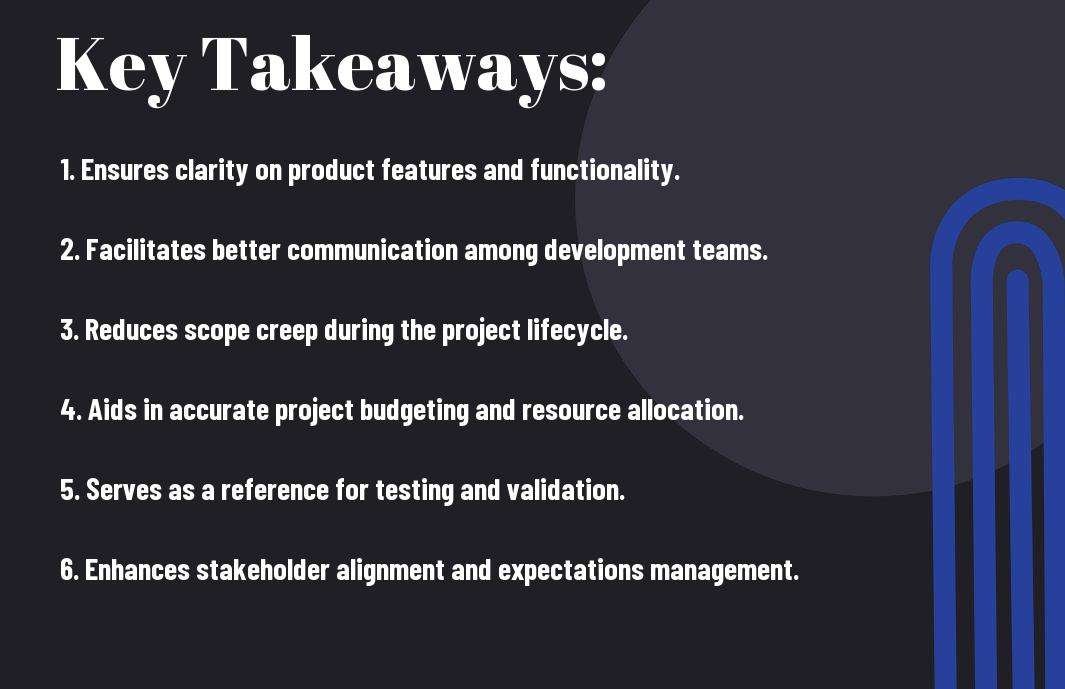With a clear and comprehensive Technical Requirements Document (TRD), I have found that product development becomes not only smoother but also more efficient. You might be unaware, but without this document, the risk of miscommunication and costly mistakes increases dramatically. A well-crafted TRD serves as a roadmap, guiding your team through each phase of development while ensuring that project goals align with business objectives. Understanding the importance of this document can enhance your team’s performance and lead to successful product launches.
Key Takeaways:
- Clarity: A Technical Requirements Document (TRD) provides a clear and detailed framework that outlines the specifications and features of the product, ensuring that all team members are aligned on the expectations.
- Efficiency: By defining requirements upfront, a TRD streamlines the development process, minimizing misunderstandings and reducing the likelihood of costly revisions later in the project lifecycle.
- Stakeholder Communication: The document serves as a communication tool between developers, project managers, and stakeholders, facilitating collaboration and ensuring that everyone is informed and engaged throughout the development process.

Understanding Technical Requirements Documents
Before exploring into product development, it is imperative to establish a clear understanding of what a Technical Requirements Document (TRD) entails. This document serves as a roadmap for both teams and stakeholders, outlining the imperative requirements and specifications needed for successful product delivery.
Definition and Purpose
Behind every successful product lies a comprehensive Technical Requirements Document. A TRD is designed to articulate the functional and non-functional requirements of a project. Its primary purpose is to ensure that all stakeholders are aligned on expectations and to serve as a reference throughout the development cycle.
Key Components
An effective TRD encompasses several critical components. These include a clear project overview, detailed functional requirements, non-functional requirements, constraints, and acceptance criteria. Each of these elements plays a vital role in guiding the development process and mitigating misunderstandings.
Also, it is important to provide a thorough project overview to set the context, along with detailed functional requirements that specify what the system should accomplish. Don’t overlook the non-functional requirements like performance, security, and usability—these are just as vital. Including constraints that outline any limitations or dependencies ensures everyone is aware of the boundaries. Lastly, establishing clear acceptance criteria allows your team to measure success effectively, making it easier to validate whether the product meets the defined specifications. Each of these components minimizes the risk of scope creep and enhances the quality of the final product.
Benefits of a Technical Requirements Document
Now, the advantages of having a Technical Requirements Document (TRD) in product development are substantial. The TRD not only clarifies what needs to be built but also serves as a reference point throughout the project lifecycle. For more detailed insights, you can check What is a Technical Requirement Document?. This documentation ultimately leads to a streamlined process and mitigates the risk of misunderstandings.
Alignment Across Teams
Below, the alignment across teams is significantly enhanced when everyone has access to a well-defined TRD. This document ensures that all departments, from development to marketing, are on the same page regarding project goals and specifications. By having a unified source of information, I find it easier to avoid any potential miscommunication that could delay the project.
Enhanced Project Management
Behind the scenes, enhanced project management stems from having a focused TRD, guiding project timelines and resources effectively. With clear technical requirements, I can allocate tasks based on team strengths, ensuring that everyone understands their responsibilities and deadlines. This clarity helps track progress and makes it simpler to identify potential bottlenecks early on.
Another aspect of enhanced project management is that missing expectations or scope creep can be effectively managed with a TRD. When the requirements are clearly documented, team members can stay within defined boundaries, thus making the development process more efficient. By aligning tasks with objectives, you can also improve team morale since everyone understands how their contributions fit into the larger picture. Overall, a TRD is indispensable for maintaining focus and achieving project success.
Best Practices for Creating a Technical Requirements Document
After defining the purpose of your document, I recommend following best practices to enhance clarity and effectiveness. Start by establishing a consistent structure that outlines your requirements clearly, utilizing diagrams and examples where necessary. Ensure the language is precise and avoid ambiguity, as this will significantly reduce misinterpretations later in the development process. Consistent formatting throughout the document also plays a pivotal role in ensuring readability and comprehension, making it an invaluable reference for everyone involved.
Involving Stakeholders
Along the way, I find it vital to involve all relevant stakeholders in the creation of the technical requirements document. Gathering insights from developers, project managers, and end-users ensures that the final requirements reflect a comprehensive understanding of needs and expectations. This collaborative approach not only fosters ownership but also minimizes the chances of overlooking vital aspects that could impact the project’s success.
Continuous Updates and Revisions
To maintain the document’s relevance and accuracy, it’s important to schedule time for continuous updates and revisions as the project evolves. As new insights emerge or project parameters change, I encourage you to revisit the document to reflect these shifts. This prevents outdated information from leading to misalignment among teams and potential setbacks in product development.
Even the most detailed technical requirements document can become outdated rapidly as technology and project scope evolve. By committing to regular updates, I ensure that the document remains a valuable resource throughout the development lifecycle. It’s important to note that neglecting updates can lead to significant misunderstandings and challenges down the line. Establish a formal process for revisions and clearly communicate these updates across your team to maintain alignment and foster continued collaboration.
Common Challenges and Solutions
Many teams encounter various challenges when developing a technical requirements document. These challenges can hinder productivity and lead to project delays. By addressing these obstacles proactively and implementing effective solutions, you can streamline your development process and ensure a smoother path to success.
Miscommunication Issues
On many occasions, miscommunication between stakeholders can lead to significant misunderstandings. These issues often arise from ambiguous language or varying interpretations of requirements. By fostering an environment of open communication and regular updates, you can reduce the gaps in understanding and align everyone on the project’s vision.
Evolving Requirements
About the nature of projects, it is important to acknowledge that requirements often evolve. As you progress, you may discover new technologies, market shifts, or user feedback that necessitate changes to your initial plans. Embracing agility in your development approach allows you to adapt to these changes without derailing your project, making it easier to incorporate valuable insights into the final product.
This means you should be prepared for a dynamic project environment where flexibility is key. Regularly revisiting the technical requirements document helps in identifying these evolving needs and incorporating them effectively. By prioritizing adaptability, I can ensure that my development efforts produce a product that truly meets user expectations while also staying ahead in the competitive landscape.

Case Studies: Successful Implementation
Once again, the impact of a Technical Requirements Document in product development can be seen in successful case studies:
- XYZ Corp: Reduced development time by 30% through clear technical specifications.
- ABC Software: Increased user satisfaction by 25% using a dedicated requirements gathering process.
- Tech Innovations: Achieved a 40% decrease in post-launch bugs by incorporating a thorough requirements assessment.
- Gadget Limited: Enhanced project collaboration, leading to a 50% faster release cycle by implementing a requirements framework.
For more information on this topic, you can check out What Is a Product Requirements Document (PRD)?
Examples in Software Development
Behind many successful software initiatives is the adherence to a Technical Requirements Document. Companies like Google and Microsoft have utilized these documents to streamline their development processes and enhance team collaboration, leading to notable advancements in software applications.
Examples in Hardware Development
Below the surface, the backbone of successful hardware projects often lies in a well-crafted Technical Requirements Document. If you consider the likes of Apple and Tesla, their innovation can be attributed to meticulously defined requirements that guide every aspect of their product development.
But the impact of a well-executed Technical Requirements Document extends far beyond mere documentation. For instance, inaccuracies in hardware specifications can result in not only costly delays but also endanger user safety. It’s important to note that while effective communication between teams is enhanced by these documents, neglecting detailed technical requirements can lead to severe operational challenges and negatively affect customer satisfaction. Therefore, investing in comprehensive technical documentation is vital for the success of your hardware projects.
Tools and Resources for Developing Technical Requirements
Not all tools are created equal when it comes to developing your technical requirements document. You’ll find a variety of specialized software designed to streamline the process, enhance collaboration, and foster clear communication among team members, ensuring that all aspects of the project are thoroughly outlined and understood.
Document Templates
Document templates serve as a beneficial starting point for your technical requirements. By utilizing these pre-designed frameworks, I can save time and ensure that I address all necessary components consistently. Templates often come with sections for scope, functionality, and diagrams, which keep my document organized and professional.
Collaboration Tools
Any successful product development process requires effective collaboration tools that allow team members to communicate seamlessly. Utilizing platforms like Slack, Trello, or Microsoft Teams helps you manage your project efficiently, ensuring everyone is on the same page.
Also, collaboration tools allow for real-time updates, which can be particularly beneficial during sprint cycles or when deadlines are approaching. With the ability to share documents, receive feedback, and track changes instantly, your team can make informed decisions more quickly. Make sure to choose tools that suit your team dynamics, as the right choice can significantly enhance productivity and reduce the likelihood of misunderstandings in your technical requirements.
Final Words
Summing up, a Technical Requirements Document is necessary in product development because it serves as a comprehensive guide for you and your team throughout the project lifecycle. By clearly defining your project’s goals, specifications, and constraints, you ensure that everyone is aligned and can effectively avoid misunderstandings. Utilizing resources like Agile Requirement Documents: Your Product Blueprint can further enhance your approach to managing these critical requirements, leading to a smoother, more efficient development process.
FAQ
Q: What is a Technical Requirements Document and why is it important in product development?
A: A Technical Requirements Document (TRD) is a detailed description of the technical requirements for a product or project. It serves as a foundation for the development process by outlining the specifications, functionalities, and performance criteria that the product must meet. The importance of a TRD in product development lies in its role as a guiding document that ensures all stakeholders have a clear understanding of the technical needs and goals of the project, reducing ambiguity and aligning efforts among team members.
Q: How does a Technical Requirements Document help in minimizing project risks?
A: A well-prepared Technical Requirements Document helps in identifying potential risks early in the product development process. By clearly defining what is required technically, it allows teams to foresee challenges that might arise during development and address them proactively. This foresight allows teams to allocate resources effectively, plan for contingencies, and ensure that engineering efforts are aligned with the stakeholders’ expectations, thus minimizing the chances of project delays or failures.
Q: Who should be involved in creating a Technical Requirements Document?
A: The creation of a Technical Requirements Document should involve a collaborative effort from various stakeholders, including product managers, developers, designers, and quality assurance professionals. Engaging these individuals ensures that the document reflects a comprehensive view of the necessary technical specifications and that all perspectives are considered. Additionally, obtaining feedback from end-users and clients can provide further insights into the requirements, ultimately leading to a more effective and user-centric product development process.







